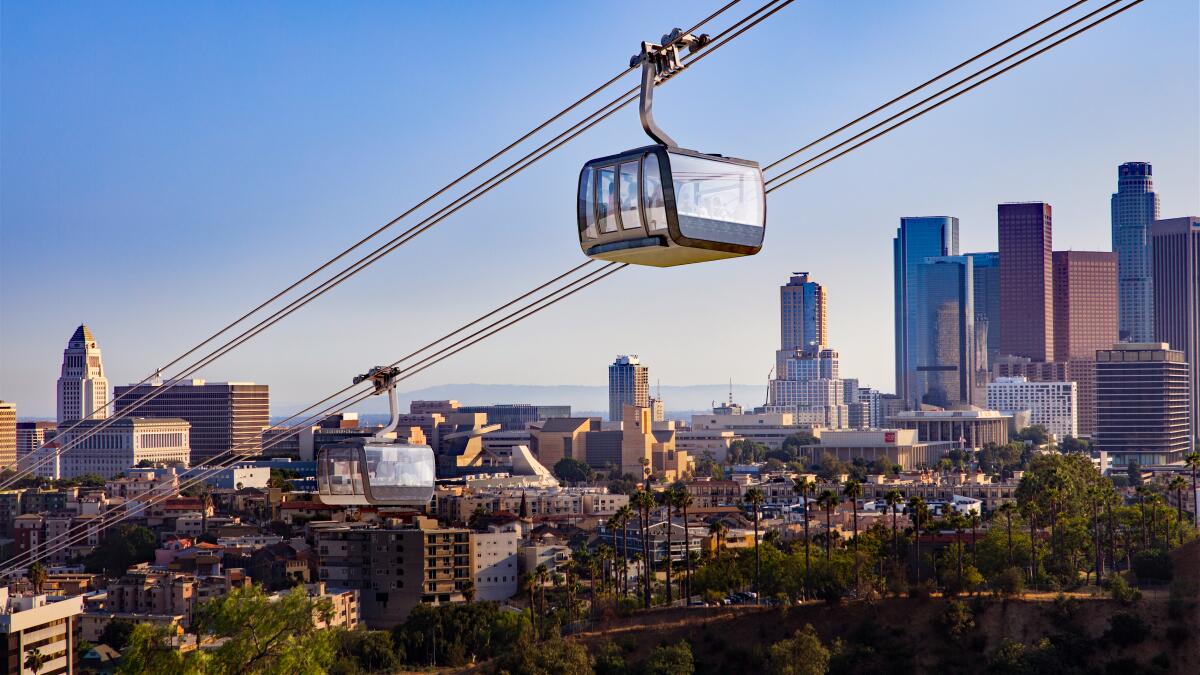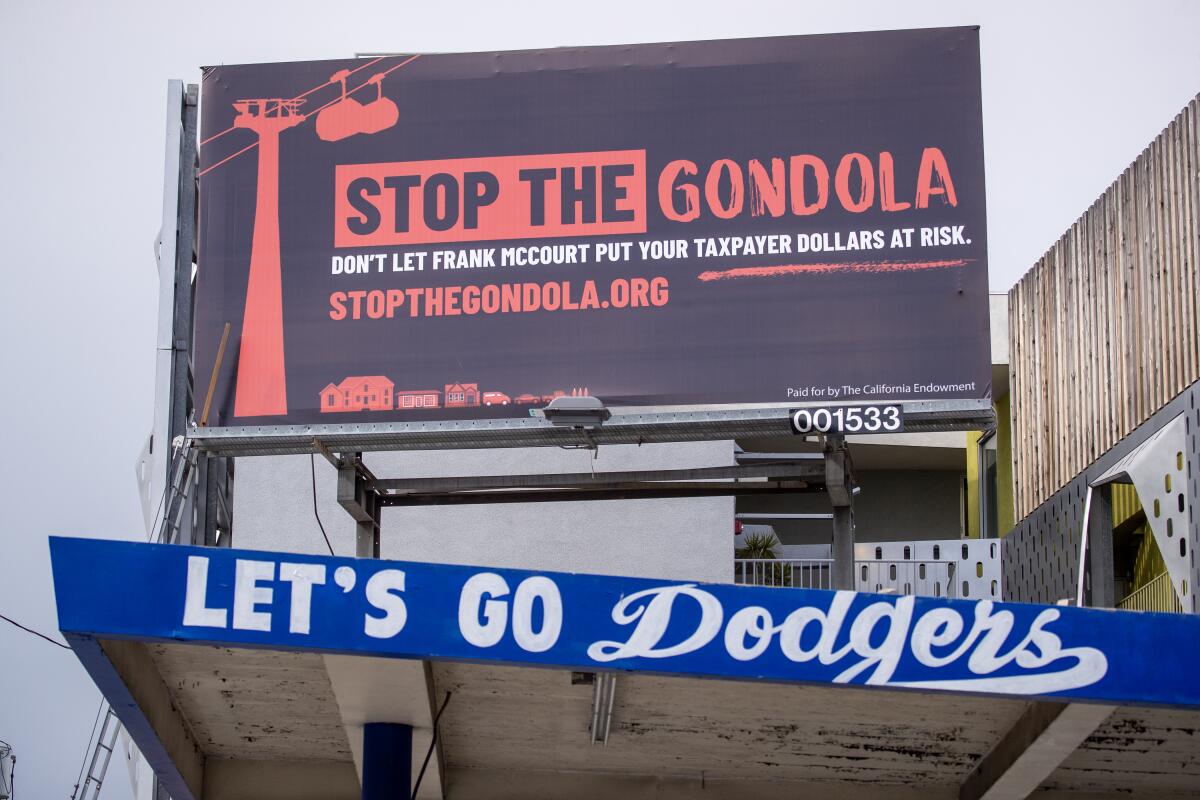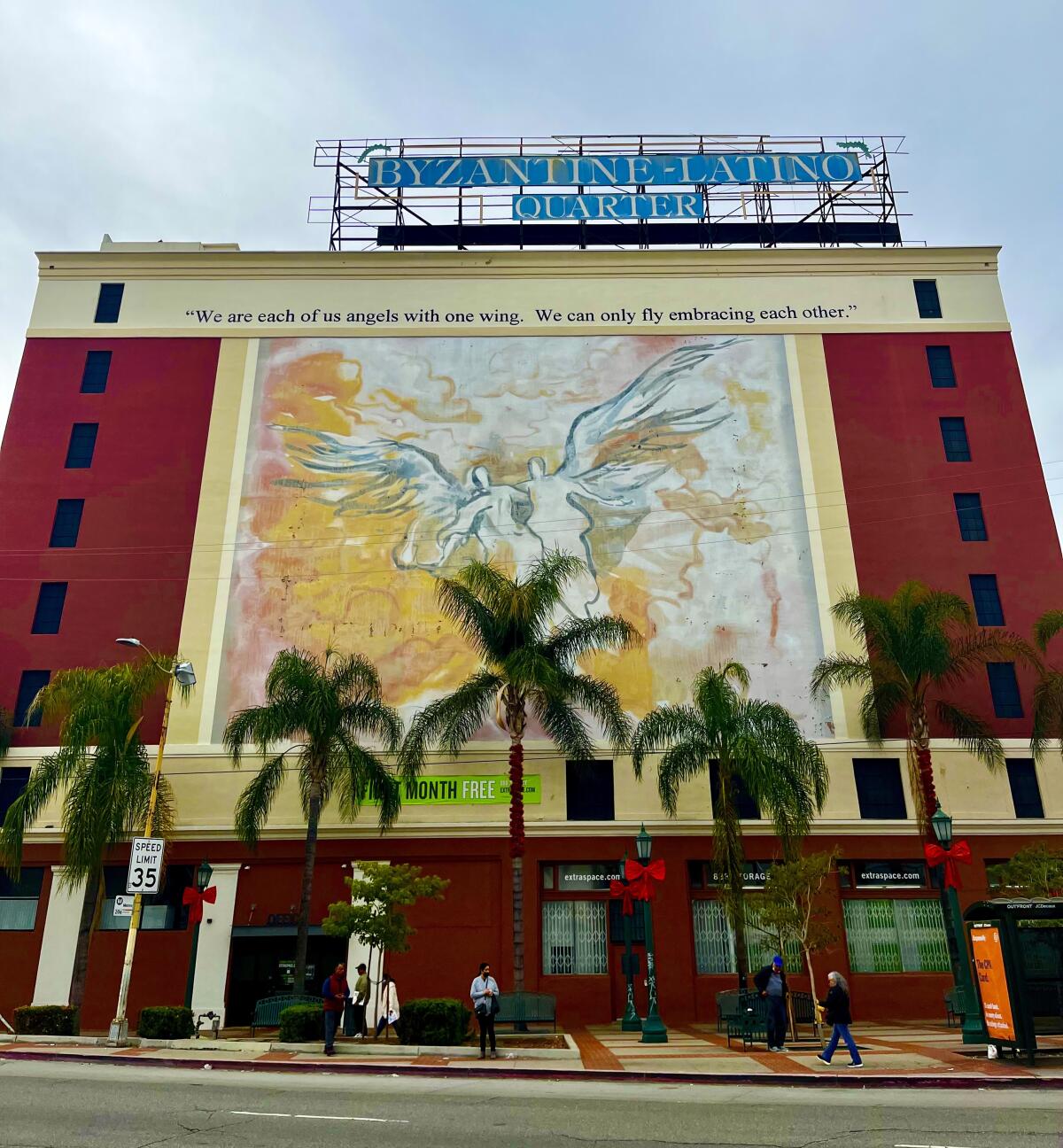Does L.A. gondola plan signal a larger development next to Dodger Stadium?

- Share via
Good morning, and welcome to the Essential California newsletter. It’s Monday, May 1.
Los Angeles’ iconic Dodger Stadium is an island surrounded by a sea of asphalt and faded white lines denoting where more than 18,000 drivers can park their cars.
And when it’s time for Dodger baseball, cars clog up nearby freeways, main roads and neighborhood streets in the slow-moving process to funnel spectators up to the parking lots and into the storied ballpark.
There have been a few ideas floated to ease congestion on game days, including Elon Musk’s much-hyped but never-dug hyperloop tunnel. But there’s another proposal gaining altitude: an aerial gondola between Union Station and Dodger Stadium, pitched as “an innovative, emissions-free solution to traffic around Dodger Stadium,” according to its backers.
The gondola has been framed as a way to fight congestion while whisking 5,000 passengers per hour in each direction, with a proposed midway station where Chinatown meets Los Angeles State Historic Park.
L.A. Metro is leading the planning of the project, while the financing, construction and operation are being handled by the nonprofit Climate Resolve, through its subsidiary Zero Emissions Transit. But the project originated with an LLC known as Los Angeles Aerial Rapid Transit, which is now gifting the project to the nonprofit. And you might know the name of one of that venture’s key stakeholders: Frank McCourt, former owner of the Dodgers.
“Yes, the one who dragged the storied team into bankruptcy amid Major League Baseball allegations he had ‘looted’ $189 million from team revenues for personal use,” Times sportswriter Bill Shaikin recounted in a new column. “And, yes, the one who laughed all the way to the bank, selling the Dodgers for a billion-dollar profit in 2012.”
But though McCourt sold the team and stadium, he held on to the parking lots that surround the ballpark. That’s where the terminus of the proposed gondola line would go, allowing fans to bypass car congestion with a free and scenic ride up the hill.

Not everyone is a fan of the gondola plan, with some community members expressing fears of gentrification. The California Endowment, a nonprofit with offices right under the gondola’s proposed path, has organized a coalition opposing what they call a “vanity project” by McCourt, who they claim is getting “a free pass without any real community input and oversight” by L.A. Metro. They’ve funded anti-gondola billboards that name McCourt.
Just a gondola?
Perhaps the most puzzling factor: for the vast majority of the year, Dodger Stadium is a ghost town. Other than the minimum 81 regular season home games, plus the hoped-for playoff berths and a light sprinkle of concerts in the off-season, the parking lots are barren.
How is a project that is expected to cost at least $300 million to build and up to $10 million to operate each year going to pay for itself if it’s free for riders?
“That leaves skeptics within the community to wonder why McCourt would promote a gondola ride to a stadium parking lot that would be empty three out of every four days during the year,” Shaikin writes. “Unless, of course, the lot would not be empty.”
Shaikin attempted to get to the bottom of that question but found it nearly impossible to get straight answers about what the gondola would mean for future development around Dodger Stadium.
One person familiar with the Dodgers’ business model told Shaikin:
“It does not make sense for the Dodgers to do it if they’re going to lose parking revenue. It does make sense if the gondola is serving a larger development.”
And as Shaikin points out, if development were to follow, making Chavez Ravine a year-round destination, that would only increase traffic to the hilltop. Hard to spin the gondola as a climate win at that point.
But for now, the answer to if the gondola is a cable-running harbinger of development to come remains up in the air. Despite Shaikin’s attempts to reach McCourt directly for comment, the billionaire was “not available,” per a spokesperson.
In the meantime, speculation abounds for what could be built up on the asphalt. One theory for mixed-use development includes affordable housing — a touch ironic given the ugly history of Chavez Ravine.
Would people ride it?
A 2022 environmental impact report for the project estimates that 10,000 people would ride the gondola to each game by 2042.
A report from transportation researchers at UCLA that same year questioned those projections. Using an existing array of transportation data to simulate “the individual choices that millions of travelers will make when something changes,” they came to different estimates. The report states:
[Researchers] found that the gondola could reduce traffic on major roads around Dodger Stadium on the night of a sold-out game, but the impact would likely be very limited. They found that the gondola likely would take only around 608 cars off the road. The gondola is thus unlikely to significantly reduce greenhouse gas emissions and traffic overall.
A congestion solution already on the road
In the meantime, visitors to Dodger Stadium don’t have to wait for an efficient and free alternative to driving their car to the game — one has existed for more than a decade.
L.A. Metro’s Dodger Stadium Express ferries fans to the stadium from both Union Station and Harbor Gateway Transit Center on reduced-emission buses.
That’s typically my choice to get to Dodger games. I walk to the nearest L (Gold) Line station in Pasadena, ride it to Union Station, then hop on the free bus for the trip up the hill along Sunset Boulevard, where the fan-filled vehicles get their own dedicated lane to breeze by crawling car drivers.
That transit-rich round trip costs me $3.50. Compare that to the $27 it costs for standard stadium parking ($30 if you don’t pay in advance). That $23-plus savings can cover my Dodger Dog and a down payment on a beer.
Just before the pandemic, the free Metro service recorded its highest ridership ever — 377,180 passengers in 2019, which includes both service lines from Union Station and Harbor Gateway Transit Center. But that pales in comparison to how many baseball fans drive to the stadium, clogging up surrounding streets. The Dodgers reported paid attendance at the stadium surpassed 3.9 million that same year. So, assuming everyone riding the free bus was attending a game (a fair assumption since there’s nothing else to do up there), their non-car trips represented roughly 9.5% of travel to the stadium that season (side note: there are a brave few who opt to walk or bike up the hill).
That’s a bit of data to go along with what you can see for yourself if you end up near Dodger Stadium on a game day: the vast majority of people are driving there — and a gondola by itself would do little to change that.
You can read Bill Shaikin’s full column on the project here.
And now, here’s what’s happening across California:
Note: Some of the sites we link to may limit the number of stories you can access without subscribing.
L.A. STORIES
Angelenos are set to see rain and cooler temperatures through most of this week as a slow-moving storm spins into the L.A. Basin. The National Weather Service is predicting a quarter- to a half-inch of rain, with thunderstorms possible midweek. Los Angeles Times
Music legend and longtime cannabis advocate Willy Nelson celebrated his 90th birthday with a two-day, star-studded bash at the Hollywood Bowl. That sparked the interest of Times writer Adam Tschorn, who spoke with concertgoers to find out “what they were firing up for the evening, what their go-to concert enhancements were and what nuggets of weed wisdom they’d learned over the years.” Los Angeles Times
CRIME, COURTS AND POLICING
The L.A. County Sheriff’s Department is investigating a memo in which a station captain allegedly refused to consider a Black sergeant for a promotion based on his race. That sergeant had previously sued the county, alleging discrimination and retaliation after he testified to an oversight committee about the existence of deputy gangs within the department. Los Angeles Times
People incarcerated in San Diego County jails say the facilities are perilous for people with disabilities, citing stories of wheelchairs being confiscated and failures to provide sign-language interpreters. A group of them are suing, demanding that the county improve conditions to comply with federal disability-rights law. San Diego Union-Tribune
Support our journalism
HEALTH AND THE ENVIRONMENT
Molok Luyuk, which means “Condor Ridge” in the indigenous Yocha Dehe Wintun tribal language, is renowned for its rich geological and biological diversity. Tribal members, along with a group of conservationists, geologists and botanists, are now pushing for President Biden to make the mountain ridge part of the national monument it borders. Sacramento Bee
The projected annual price tag for earthquake damage in California has soared. The most recent estimate: $9.7 billion, up 157% from the previous projection. As Rong-Gong Lin reports, the seismic inflation is being fueled by “an increase in property values and better understanding of how soft soils could result in greater damage during shaking.” Los Angeles Times
CALIFORNIA CULTURE
California has been well represented in this year’s NBA playoffs. But there’s one less Golden State team in the mix now, thanks to the Golden State Warriors, who dominated the Sacramento Kings in Game 7 to advance to the Western Conference semifinals. The in-state action continues for the Warriors as they face the Lakers at home in Game 1 on Tuesday night. San Francisco Chronicle
Over the weekend, NASA’s Jet Propulsion Laboratory held its first open house in four years, inviting some 36,000 space fans inside the legendary facility. There, attendees get a close-up look at the kinds of vehicles currently roving and flying on Mars, along with spacecrafts under construction for future interstellar missions. LAist
Free online games
Get our free daily crossword puzzle, sudoku, word search and arcade games in our new game center at latimes.com/games.
AND FINALLY
Today’s California landmark is from Alexandra T. of Los Angeles: the Byzantine-Latino Quarter mural overlooking L.A.’s Pico-Union neighborhood.

Alexandra writes:
Below the neon sign, two angels fly supporting each other, with text reading: “We are each of us angels with one wing. We can only fly embracing each other.” This neighborhood was once the closest thing L.A. had to a Greek Town; all that remains today is the Papa Cristo’s restaurant and deli and the St. Sophia Greek Orthodox Cathedral on the same corner. Now the area is home to immigrants from Latin America and all over the world. All these communities came together to revitalize the neighborhood, protecting its rich history and securing its future as a home for all. This sign and mural were erected in honor of that pledge.
What are California’s essential landmarks? Fill out this form to send us your photos of a special spot in California — natural or human-made. Tell us why it’s interesting and what makes it a symbol of life in the Golden State. Please be sure to include only photos taken directly by you. Your submission could be featured in a future edition of the newsletter.
Please let us know what we can do to make this newsletter more useful to you. Send comments to [email protected].
Sign up for Essential California
The most important California stories and recommendations in your inbox every morning.
You may occasionally receive promotional content from the Los Angeles Times.




